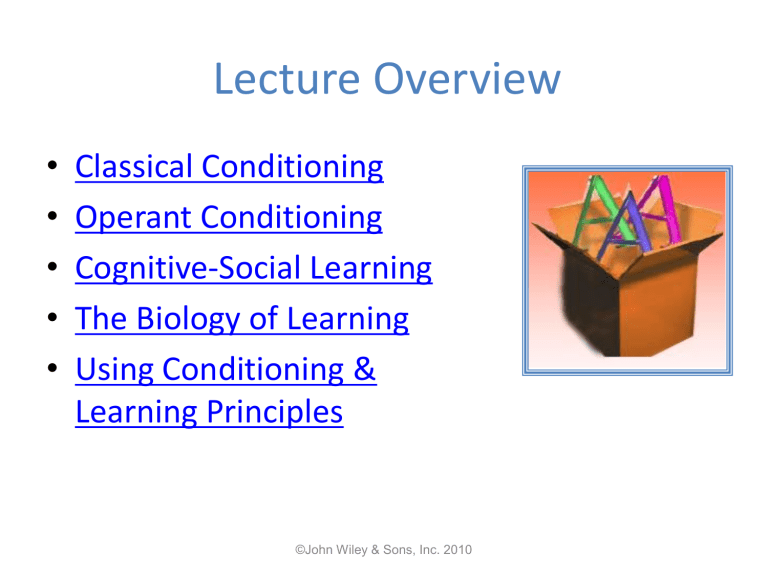Chapter 6

Lecture Overview
• Using Conditioning &
Learning Principles
©John Wiley & Sons, Inc. 2010
Introductory Definitions
• Learning: relatively permanent change in behavior or mental processes resulting from practice or experience
• Conditioning: process of learning associations between environmental stimuli & behavioral responses
©John Wiley & Sons, Inc. 2010
• Ivan Pavlov
Classical Conditioning
• Classical Conditioning: learning that occurs when a previously neutral stimulus
(NS) is paired (associated) with an unconditioned stimulus (UCS) to elicit a conditioned response (CR)
©John Wiley & Sons, Inc. 2010
Pavlov’s Original Experiment
©John Wiley & Sons, Inc. 2010
Classical Conditioning--Key Terms
• Neutral Stimulus (NS): before conditioning doesn’t naturally elicit response of interest
• Unconditioned Stimulus
(UCS): elicits UCR without prior conditioning
• Unconditioned Response (UCR): unlearned reaction to
UCS occurring without prior conditioning
©John Wiley & Sons, Inc. 2010
Classical Conditioning--Key Terms
(Continued)
• Conditioned Stimulus (CS): previously NS that, through repeated pairings with UCS, now causes a CR
• Conditioned Response (CR): learned reaction to a CS occurring because of prior repeated pairings with an
UCS
©John Wiley & Sons, Inc. 2010
©John Wiley & Sons, Inc. 2010
Pause & Reflect:
Psychology at Work
• Why study psychology? It helps you understand & enjoy popular cartoons—like this one!
©John Wiley & Sons, Inc. 2010
Classical Conditioning (Continued)
• Conditioned Emotional
Response (CER): emotional responses are classically conditioned to a previously neutral stimulus (NS)
John B. Watson
©John Wiley & Sons, Inc. 2010
Watson & Rayner Created a CER— Little
Albert’s Fear of Rats
©John Wiley & Sons, Inc. 2010
Six Basic Principles of Classical Conditioning
©John Wiley & Sons, Inc. 2010
Basic Principle— Acquisition and Conditioning
Sequences : influenced by timing
©John Wiley & Sons, Inc. 2010
Basic Principle: Stimulus
Generalization
• Stimulus Generalization: learned response to stimuli that are similar to the original conditioned stimuli
(CS)
• Stimulus Discrimination: complements generalization; one learns to differentiate among similar stimuli.
©John Wiley & Sons, Inc. 2010
Basic Principles —Extinction & Spontaneous Recovery
• Extinction : gradual weakening or suppression of a previously conditioned response (CR) if no unconditioned stimulus
(UCS) is presented
• Spontaneous Recovery : reappearance of a previously extinguished conditioned response (CR)
©John Wiley & Sons, Inc. 2010
Extinction Vs. Spontaneous Recovery
©John Wiley & Sons, Inc. 2010
Basic Principles —Higher Order
Conditioning
• Higher-Order Conditioning: neutral stimulus (NS) becomes a conditioned stimulus (CS) through repeated pairings with a previously conditioned stimulus (CS)
©John Wiley & Sons, Inc. 2010
Higher-Order Conditioning
©John Wiley & Sons, Inc. 2010
Operant Conditioning
• Operant
Conditioning: learning in which voluntary responses are controlled by their consequences
©John Wiley & Sons, Inc. 2010
Operant Conditioning (Continued)
• Thorndike’s Contribution
• Law of Effect: probability of an action being repeated is strengthened when followed by a pleasant or satisfying consequence
©John Wiley & Sons, Inc. 2010
Operant Conditioning (Continued)
• B. F. Skinner: emphasized observable stimuli & responses
©John Wiley & Sons, Inc. 2010
Operant Conditioning’s Basic Principles
• Reinforcement: strengthening a response
– Primary & secondary reinforcers
– Positive & negative reinforcement
©John Wiley & Sons, Inc. 2010
Operant Conditioning’s Basic Principles
(Continued)
• Primary Reinforcers : normally satisfy an
unlearned biological need (e.g., food)
• Secondary Reinforcers :
learned value (e.g., money, praise)
©John Wiley & Sons, Inc. 2010
Operant Conditioning’s Basic Principles
(Continued)
• Positive Reinforcement: adding (or presenting) a stimulus, which strengthens a response & makes it more likely to recur (e.g., praise)
©John Wiley & Sons, Inc. 2010
Operant Conditioning’s Basic Principles
(Continued)
• Negative Reinforcement: taking away (or removing) a stimulus that is aversive, which strengthens a response & makes it more likely to recur (e.g., headache removed after taking an aspirin); a rat presses a bar and a shock stops.
©John Wiley & Sons, Inc. 2010
Operant Conditioning’s Basic Principles
(Continued)
©John Wiley & Sons, Inc. 2010
Operant Conditioning’s Basic Principles: Four
Partial Schedules of Reinforcement
1. Continuous Reinforcement (CRF)
2. Fixed Ratio (FR): reinforcement occurs after a predetermined set of responses; the ratio
(number or amount) is fixed (e.g. every two times rat bar presses, food appears).
3. Variable Ratio (VR): reinforcement occurs on average; the ratio (number or amount) varies, but averages two.
©John Wiley & Sons, Inc. 2010
Operant Conditioning’s Basic Principles: Four
Partial Schedules (Continued)
3. Fixed Interval (FI): reinforcement occurs after a predetermined time has elapsed; the
interval (time) is fixed (e.g., paycheck)
4. Variable Interval (VI): reinforcement occurs unpredictably; the interval (time) varies
(e.g., pop quiz)
©John Wiley & Sons, Inc. 2010
Operant Conditioning’s Basic Principles:
Four Partial Schedules (Continued)
©John Wiley & Sons, Inc. 2010
Operant Conditioning’s Basic Principles: Four
Partial Schedules (Continued)
©John Wiley & Sons, Inc. 2010
Operant Conditioning’s Basic
Principles (Continued)
• Shaping: reinforcement is delivered after successive approximations of the desired response
©John Wiley & Sons, Inc. 2010
• Variable ratio
• Fixed Ratio
• Variable Interval
• Fixed Interval
©John Wiley & Sons, Inc. 2010
Operant Conditioning’s Basic Principles
(Continued)
• Punishment: weakening a response
– Positive and negative punishment
©John Wiley & Sons, Inc. 2010
Operant Conditioning’s Basic Principles
(Continued)
• Positive Punishment: adding (or presenting) a stimulus that weakens a response & makes it less likely to recur (e.g., shouting at a child)
©John Wiley & Sons, Inc. 2010
Operant Conditioning’s Basic
Principles (Continued)
• Negative Punishment: taking away (or removing) a stimulus that weakens a response & makes it less likely to recur; taking away a favorite toy from a child
©John Wiley & Sons, Inc. 2010
©John Wiley & Sons, Inc. 2010
Cognitive-Social Learning
• Cognitive-Social
Learning: emphasizes the roles of thinking & social learning in behavior
©John Wiley & Sons, Inc. 2010
Cognitive-Social Learning (Continued)
• Kohler’s chimps insight learning
(sudden understanding of a problem that implies the solution).
©John Wiley & Sons, Inc. 2010
Cognitive-Social Learning (Continued)
• Tolman’s rats built a cognitive map (a mental image of a three-dimensional space). They also displayed latent learning (hidden learning that exists without behavioral signs).
©John Wiley & Sons, Inc. 2010
Cognitive-Social Learning (Continued)
• Observational
Learning: learning new behaviors or information by watching & imitating others
Bandura's Famous
Bobo Doll study
©John Wiley & Sons, Inc. 2010
Cognitive-Social Learning (Continued)
• Observational Learning involves four processes:
1. Attention
2. Retention
3. Reproduction
4. Motivation ( from reinforcement)
©John Wiley & Sons, Inc. 2010
©John Wiley & Sons, Inc. 2010
The Biology of Learning: Neuroscience
& Learning
• General findings: Learning leads to new synaptic connections & alterations in many brain structures.
The “Engram.”
©John Wiley & Sons, Inc. 2010
The Biology of Learning: Neuroscience
& Learning
• Enriched vs deprived environments lead to biological changes in both behavior and mental processes.
©John Wiley & Sons, Inc. 2010
The Biology of Learning: Evolution &
Learning
• Biological Preparedness: built-in (innate) readiness to form associations between certain stimuli & responses
– Taste Aversion: classically conditioned, one trial learning: negative associations of food with illness
©John Wiley & Sons, Inc. 2010








